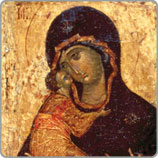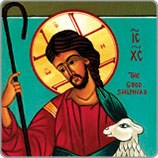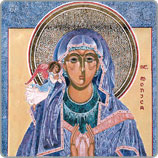Icons as Religious Art
Icons are very popular today. Look at the toolbar on a computer. Each little symbol means something—volume control, Internet connection, media player, and so on. Each one represents a greater object, such as a program or process, and gives the user a quick link to that object.

Religious icons are similar in that they are also symbols or representations of a greater “object,” but in this case, the “object” is a person: Christ or one of the saints in heaven. Icons are like quick links in that they give us a kind of symbolic snapshot of holy persons who are in heaven. More than that, religious icons are a form of prayer. When you look at an icon, it is meant to make you aware that you are in the presence of God. Icons, then, are not just art with a religious theme; rather, they are sacred art because they bring the viewer to the sacred.
Icons have been called windows to heaven or doorways to the sacred. When you are standing in front of an icon, it is as if you are looking through a window into the heavenly world of the mystery. But this is a two-way window. As you look though the window, you are also being seen with the eyes of love by those in the icon. It’s like you become a part of the mystery that the icon seeks to express.
In addition to the style of the painting (or writing as it is called), the actual technique of making an icon is rich with symbolism. For example, in the Eastern Church tradition, icons are painted on high-quality wood that has been carefully shaped and smoothed. The wood is a reminder of what life was like before the fall of Adam and Eve. It symbolizes both the Tree of Life and the Tree of Knowledge. A linen cloth covers the wood, both to protect it and to remind us of the cloth that Jesus was wrapped in when he died. Coats of gesso made from rabbit-skin glue and chemists’ chalk are applied over the linen. This symbolizes the soul and life of the person.

The iconographer cleans, smoothes, and prepares the gesso to receive the holy image, much as we prepare ourselves to bear the image of Christ. The board is indented so that the edges appear raised. The center part of the wood board is shallower than the rest and is called covcheg, which is Russian for “coffin.” The image is placed inside this shallow space. It is etched into the gesso. A thin layer of clay bole (a mixture of clay and hide glue) is applied to the areas of the icon that will be gilded with gold leaf. The clay represents our physical nature. To apply gold, the iconographer breathes on the clay bole to vaporize it and immediately places the gold leaf on the damp area. This process symbolizes the Spirit and reminds us of the act of creation and the breath of life. The gold itself symbolizes divine light and heaven. Icons often have gold backgrounds because the viewer is gazing at someone in heaven. The image is painted with a mixture of egg yolk, pure water, vinegar, and natural pigments. Many layers are applied, each with their own color symbolism.

There are many other symbols used in writing icons. These are just a few to show that icons are more than pretty pictures. They are a visual form of prayer in line and color that seek to tell us something true about God and the saints. They follow a long tradition of truths that are communicated visually rather than through words, a theology passed on from one artist to the next. They are meant to help us open ourselves to God’s love.

